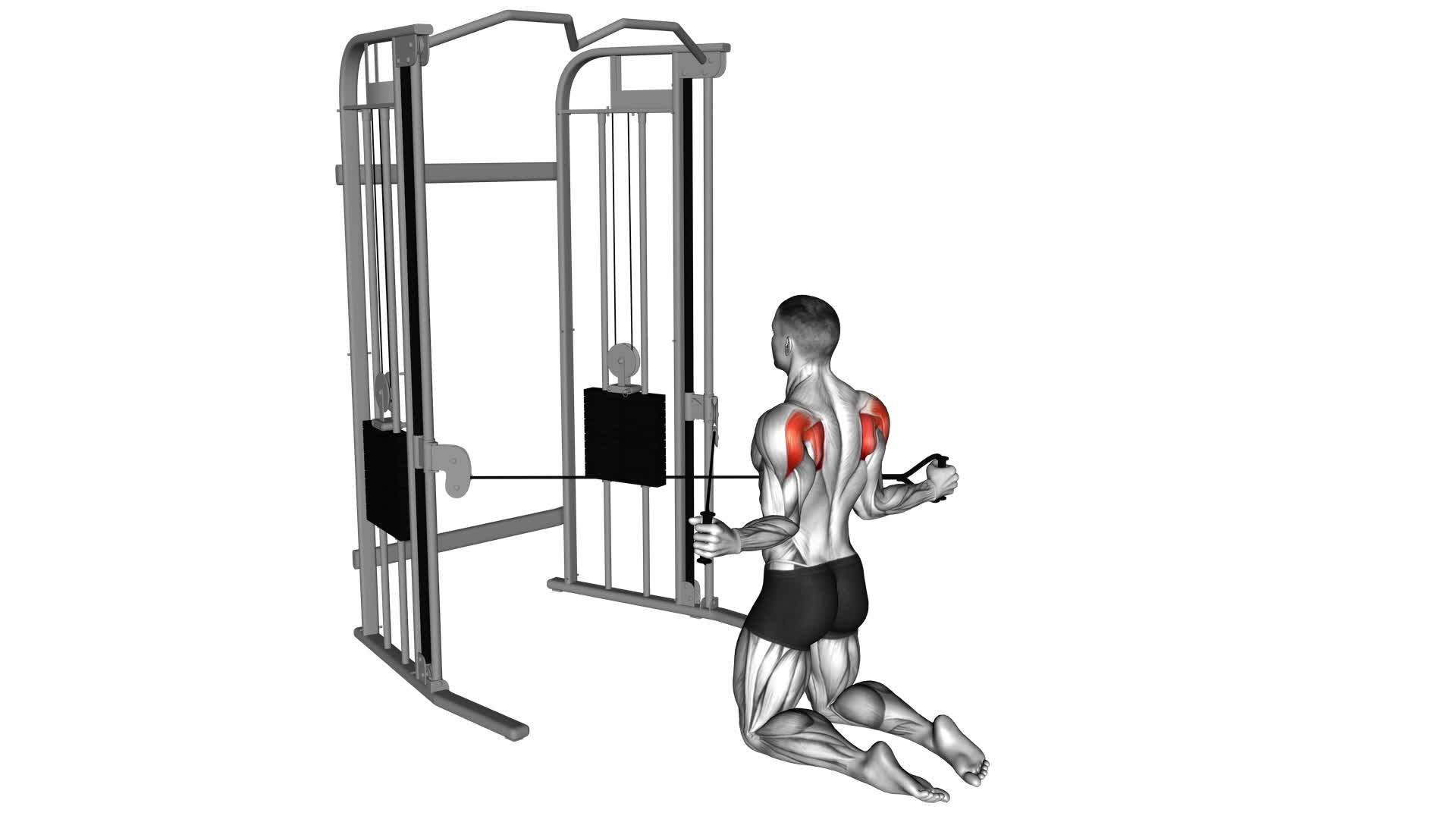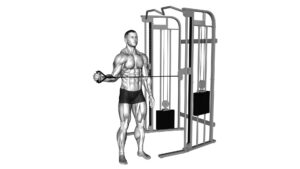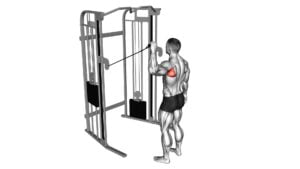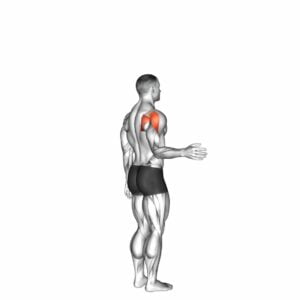Cable Kneeling Shoulder External Rotation (male) – Video Exercise Guide & Tips

Get ready to strengthen your shoulders with the cable kneeling shoulder external rotation exercise.
Watch This Exercise Video
This video exercise guide will show you the proper form and variations for maximum effectiveness.
By following these tips, you'll avoid common mistakes and get the most out of this targeted exercise.
Grab a cable and let's get started on improving your shoulder strength and stability.
Key Takeaways
- Cable kneeling shoulder external rotation strengthens and stabilizes shoulder joints.
- It improves shoulder mobility and targets the infraspinatus and teres minor muscles.
- Proper form includes maintaining a 90-degree angle at the elbow and avoiding straightening or allowing the elbow to move during rotation.
- Variations of the exercise can be done with a resistance band or by using a single arm or heavier weight for increased difficulty.
Benefits of Cable Kneeling Shoulder External Rotation
By performing cable kneeling shoulder external rotations, you can strengthen and stabilize your shoulder joints. This exercise is highly effective in improving shoulder mobility and strengthening the rotator cuff muscles. The cable kneeling shoulder external rotation specifically targets the infraspinatus and teres minor muscles, which are part of the rotator cuff. These muscles play a crucial role in stabilizing the shoulder joint and facilitating proper movement.
During this exercise, you'll start by kneeling in front of a cable machine with your side facing the machine. Grasp the handle with your outer hand and bring your elbow in line with your shoulder. Keep your elbow bent at a 90-degree angle throughout the movement. Begin by rotating your shoulder outward, away from your body, while maintaining control and stability. Slowly return to the starting position and repeat.
Proper Form for Cable Kneeling Shoulder External Rotation
To perform the cable kneeling shoulder external rotation exercise with proper form, you should ensure that your elbow remains bent at a 90-degree angle throughout the movement. This is crucial for targeting the correct muscles and maximizing the effectiveness of the exercise.
Common misconceptions about this exercise include straightening the elbow or allowing it to move during the rotation. However, maintaining a fixed 90-degree angle at the elbow is essential for isolating and strengthening the external rotators of the shoulder.
In terms of equipment needed, you'll require a cable machine with an adjustable pulley and a D-handle attachment. Adjust the pulley to a height that allows you to comfortably hold the handle at waist level.
Kneel down facing the cable machine and grasp the handle with the hand of the arm you want to work. Keep your elbow bent at a 90-degree angle and your upper arm parallel to the ground throughout the exercise.
Variations of Cable Kneeling Shoulder External Rotation
One variation of the cable kneeling shoulder external rotation exercise is to perform it with a resistance band instead of a cable machine. This variation allows for greater portability and convenience, as resistance bands are lightweight and can be easily transported. To perform this variation, attach one end of the resistance band to a stable anchor point at shoulder height. Hold the other end of the band with your elbow bent at a 90-degree angle and your forearm parallel to the floor. Keep your upper arm against your side and slowly rotate your forearm outward, away from your body, until your hand is pointing straight ahead. Hold for a brief moment and then slowly return to the starting position.
Advanced cable kneeling shoulder external rotation techniques can be used to increase the difficulty and intensity of the exercise. One technique is to perform the exercise with a single-arm instead of both arms simultaneously. This requires greater stabilization and coordination. Another technique is to use a heavier weight or resistance band to challenge the muscles further. Additionally, incorporating slow and controlled eccentric movements, where you lower the weight or resistance band slowly, can also increase the intensity of the exercise.
By incorporating these variations and advanced techniques into your cable kneeling shoulder external rotation routine, you can target different muscle fibers and challenge your muscles in new ways. This can lead to greater strength gains and improved shoulder stability.
Now let's move on to tips for maximizing the effectiveness of cable kneeling shoulder external rotation.
Tips for Maximizing the Effectiveness of Cable Kneeling Shoulder External Rotation
Maximize the effectiveness of your cable kneeling shoulder external rotation by focusing on proper form and engaging your shoulder muscles throughout the exercise. To ensure maximum shoulder mobility and engage the targeted muscles, follow these tips during your resistance training.
First, start by adjusting the cable machine so that it's at shoulder height. Stand facing away from the machine, with your feet shoulder-width apart and your knees slightly bent. Grab the handle with your palm facing up and your elbow bent at a 90-degree angle. This is your starting position.
Next, exhale and slowly rotate your shoulder externally, moving the handle away from your body. Keep your elbow in a fixed position throughout the movement. Hold the position for a brief moment, focusing on squeezing your shoulder blades together.
As you inhale, slowly return to the starting position, maintaining control and resisting the weight. Remember to keep your core engaged and your shoulder muscles activated throughout the entire exercise.
To maximize the effectiveness of this exercise, it's crucial to maintain proper form. Avoid using momentum or swinging the weight, as this reduces the engagement of the targeted muscles. Instead, focus on controlled and deliberate movements, ensuring that your shoulder muscles are doing the work.
Incorporating this cable kneeling shoulder external rotation exercise into your resistance training routine will help improve shoulder mobility and strengthen the muscles involved. Remember to start with a weight that challenges you without sacrificing proper form, and gradually increase the resistance as your strength improves. Stay consistent and reap the benefits of this effective shoulder exercise.
Common Mistakes to Avoid During Cable Kneeling Shoulder External Rotation
Avoid these common mistakes during cable kneeling shoulder external rotation to ensure proper form and maximize the effectiveness of the exercise.
One common mistake is using too much weight. It's important to start with a manageable weight that allows you to maintain proper form throughout the movement. Using excessive weight can compromise your form and increase the risk of injury.
Another mistake to avoid is allowing your elbow to flare out during the rotation. This can place unnecessary stress on the shoulder joint and reduce the effectiveness of the exercise. Keep your elbow close to your body and focus on maintaining a controlled and smooth movement.
Additionally, avoid using momentum or swinging the arm during the rotation. This takes away from the targeted muscles and reduces the effectiveness of the exercise. Instead, focus on using the muscles in your shoulder to perform the rotation in a controlled manner.
Lastly, make sure to avoid shrugging your shoulder during the exercise. Keep your shoulder down and relaxed to properly engage the muscles targeted in this exercise.
Frequently Asked Questions
How Many Sets and Reps Should I Do for Cable Kneeling Shoulder External Rotation?
For cable kneeling shoulder external rotation, the number of sets and reps will depend on your fitness level and goals. Generally, it's recommended to start with 2-3 sets of 10-15 reps.
However, you can vary the sets and reps to challenge your muscles and avoid plateaus.
Remember to maintain proper form and control throughout the exercise.
Consulting with a fitness professional can help determine the optimal sets and reps for your specific needs.
Can I Perform Cable Kneeling Shoulder External Rotation With Dumbbells Instead of a Cable Machine?
Yes, you can perform cable kneeling shoulder external rotation with dumbbells instead of a cable machine. However, it's important to note that dumbbell variations may not provide the same level of resistance and stability as cable machines.
Cable machines allow for a smooth and controlled movement, targeting the shoulder muscles effectively. If you choose to use dumbbells, make sure to maintain proper form and control throughout the exercise to maximize its benefits.
Is Cable Kneeling Shoulder External Rotation Suitable for Beginners?
Cable kneeling shoulder external rotation is a suitable exercise for beginners. To ensure proper form, keep your elbow at a 90-degree angle and your upper arm parallel to the ground. If you don't have access to a cable machine, you can modify this exercise by using dumbbells instead.
This exercise targets the muscles in your shoulders and can help improve your shoulder strength and stability. Remember to start with light weights and gradually increase as you become more comfortable.
Can Cable Kneeling Shoulder External Rotation Help With Shoulder Pain or Injury Rehabilitation?
Cable kneeling shoulder external rotation can be beneficial for shoulder pain or injury rehabilitation. By engaging the external rotator muscles, this exercise helps to strengthen and stabilize the shoulder joint.
To perform it correctly, maintain proper form by kneeling in front of a cable machine with your elbow bent at 90 degrees and your upper arm parallel to the floor. Slowly rotate your forearm outward, keeping your elbow stationary.
This motion can aid in relieving shoulder discomfort and promoting recovery.
Are There Any Specific Muscles That Cable Kneeling Shoulder External Rotation Targets?
When performing cable kneeling shoulder external rotation, you target specific muscles in the shoulder. This exercise focuses on the rotator cuff muscles, specifically the infraspinatus and teres minor.
By engaging these muscles, you can strengthen and stabilize your shoulder joint, which can be beneficial for shoulder pain or injury rehabilitation.
Cable kneeling shoulder external rotation is an effective way to target these specific muscles and improve overall shoulder function.
Conclusion
In conclusion, cable kneeling shoulder external rotation is a highly effective exercise for strengthening and stabilizing the shoulder muscles. By using proper form and variations, you can target different areas of the shoulder and maximize the effectiveness of this exercise.
Remember to avoid common mistakes and follow the tips provided to ensure safety and achieve optimal results. Incorporate cable kneeling shoulder external rotation into your workout routine to improve shoulder strength and prevent injuries.

Author
Years ago, the spark of my life’s passion ignited in my mind the moment I stepped into the local gym for the first time. The inaugural bead of perspiration, the initial endeavor, the very first surge of endorphins, and a sense of pride that washed over me post-workout marked the beginning of my deep-seated interest in strength sports, fitness, and sports nutrition. This very curiosity blossomed rapidly into a profound fascination, propelling me to earn a Master’s degree in Physical Education from the Academy of Physical Education in Krakow, followed by a Sports Manager diploma from the Jagiellonian University. My journey of growth led me to gain more specialized qualifications, such as being a certified personal trainer with a focus on sports dietetics, a lifeguard, and an instructor for wellness and corrective gymnastics. Theoretical knowledge paired seamlessly with practical experience, reinforcing my belief that the transformation of individuals under my guidance was also a reflection of my personal growth. This belief holds true even today. Each day, I strive to push the boundaries and explore new realms. These realms gently elevate me to greater heights. The unique combination of passion for my field and the continuous quest for growth fuels my drive to break new ground.







